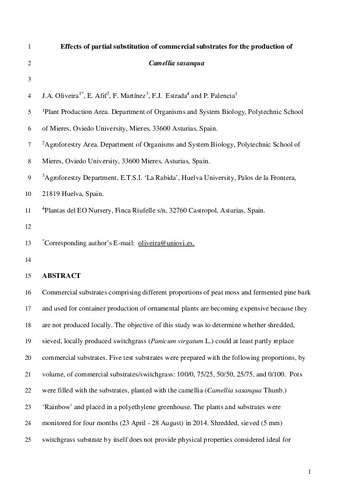Effects of partial substitution of commercial substrates for the production of Camellia sasanqua
Autor(es) y otros:
Palabra(s) clave:
Biomass
Nursery production
Camellia sasanqua
Ornamental plants
Panicum virgatum L.
Switchgrass
Fecha de publicación:
Descripción física:
Resumen:
Commercial substrates comprising different proportions of peat moss and fermented pine bark and used for container production of ornamental plants are becoming expensive because they are not produced locally. The objective of this study was to determine whether shredded, sieved, locally produced switchgrass (Panicum virgatum L.) could at least partly replace commercial substrates. Five test substrates were prepared with the following proportions, by volume, of commercial substrates/switchgrass: 100/0, 75/25, 50/50, 25/75, and 0/100. Pots were filled with the substrates, planted with the camellia (Camellia sasanqua Thunb.) ‘Rainbow’ and placed in a polyethylene greenhouse. The plants and substrates were monitored for four months (23 April - 28 August) in 2014. Shredded, sieved (5 mm) switchgrass substrate by itself does not provide physical properties considered ideal for container camellia plant production. The tallest plants were those grown in the substrates containing between 0 and 50% Switchgrass, possibly because of the good values for water holding capacity, total porosity and air-filled porosity of those blends. The density of roots decreased as the proportion of Switchgrass in the substrate increased. Switchgrass substrate can be used as a substrate component for commercial container production of camellia plants over 4 months, when mixed in a proportion of no more than 50% by volume with a commercial substrate comprising peat moss and fermented pine bark. Nevertheless, more research is required with different plants in order to confirm the results obtained so far.
Commercial substrates comprising different proportions of peat moss and fermented pine bark and used for container production of ornamental plants are becoming expensive because they are not produced locally. The objective of this study was to determine whether shredded, sieved, locally produced switchgrass (Panicum virgatum L.) could at least partly replace commercial substrates. Five test substrates were prepared with the following proportions, by volume, of commercial substrates/switchgrass: 100/0, 75/25, 50/50, 25/75, and 0/100. Pots were filled with the substrates, planted with the camellia (Camellia sasanqua Thunb.) ‘Rainbow’ and placed in a polyethylene greenhouse. The plants and substrates were monitored for four months (23 April - 28 August) in 2014. Shredded, sieved (5 mm) switchgrass substrate by itself does not provide physical properties considered ideal for container camellia plant production. The tallest plants were those grown in the substrates containing between 0 and 50% Switchgrass, possibly because of the good values for water holding capacity, total porosity and air-filled porosity of those blends. The density of roots decreased as the proportion of Switchgrass in the substrate increased. Switchgrass substrate can be used as a substrate component for commercial container production of camellia plants over 4 months, when mixed in a proportion of no more than 50% by volume with a commercial substrate comprising peat moss and fermented pine bark. Nevertheless, more research is required with different plants in order to confirm the results obtained so far.
Colecciones
- Biología de Organismos y Sistemas [762]
- Varios [87]
Ficheros en el ítem





